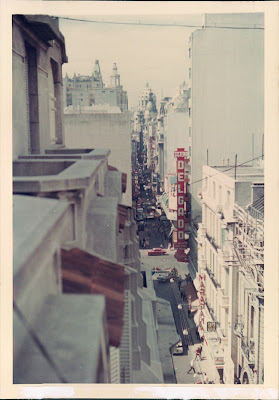We travelled across the Chilean Lakes by boat and bussed through the Andes to San Carlos de Bariloche which was starting to materialise as the major ski resort in Argentina. With a definite German/ Swiss influence in architecture, most buildings constructed from stone and wood. The atmosphere was 'lakeside alpine' generated by the early German settlers who migrated to this area and located the town in the western foothills of the Andes on the great lakes of Chile.
Our Plans changed in Bariloche, Lyn was still suffering from "Soroche" as we were still at an altitude of over 3000m and she was keen to get to city life and culture, which Buenos Aires offered. Thus my hopes and thoughts of tracing my grandparents and visiting my grandfathers grave, in Tierra del Fuego, which was still a thousand miles further south, with very rugged country still to be travelled, evaporated.,
The notion of leaving Lyn for awhile, to get there and back, a distance of over a two thousand miles was not feasible, as we had deadlines to be in Rio in February for catching a berth on a tramp steamer to Africa and also to catch Carnival. Besides, leaving a good looking blonde female in Argentina, on her own, was a recipe for some unsolicited attention which was not desired. So we made for Buenos Aires where my father was born.
 |
| Friends who we stayed with on their island residence off the coast of Santos on our way to Rio De Janeiro. |
Avenue Corrienties one of the main roads in Buenos Aires CBD
Florida Street and elegant street, renowned for shopping and leather wares
Avenida 9 de Julia one of the widest roads in the world, with the Buenas Aires obelisk in the distance.
Buenos Aires is very European, the buildings as are the wide boulevards are re-mindful of Paris, the shopping was as expected good, with variety, especially leather goods. I bought a brown suede bomber jacket and Lyn shoes and coat. We stayed on Calle Florida, an elegant narrow street lined with boutiques and cafes similar to Melbourne's lane ways, in a boutique hotel owned by an Italian Family who became our guides showing us the Port area which was renowned for the Tango.
Cafe Tortoni was one of the famous cafes not far from our hotel, which was nothing like any I had seen before and became our favourite. In Buenos Aires they are called confiterias, which is what Cafe Tortoni was - confiterias are far more than a cafe or restaurant, they make their own ice cream, pastries, own on site bakery, and wine bar.
The appointments are all in the 'grand style' gilt framed bevelled mirrors on the walls interspersed with glass cases of memorabilia of the 'who's who' who have frequented the establishment over the years. Crystal chandeliers through out, a large room broken into several spaces with a beautiful timber an brass ornamented bar and grand piano for live entertainment, tango and live poetry readings.



















































